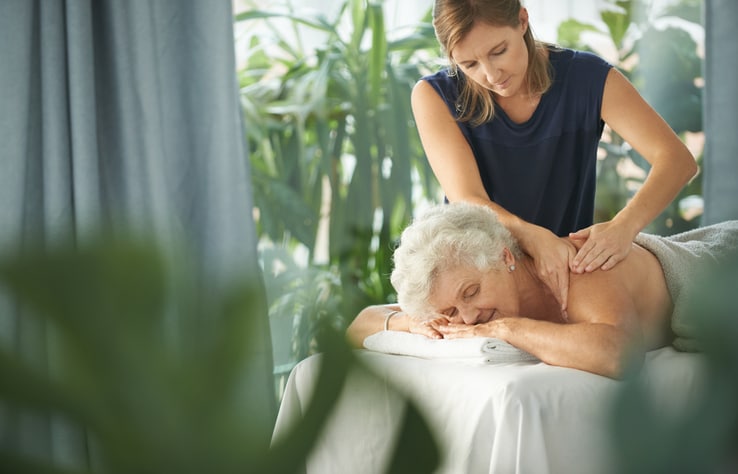Older adults often live alone and are starved for touch, which studies show is critical for well-being. Geriatric massage, a complementary therapy that’s growing in popularity, can address that lack and offer a host of physical, mental and emotional health benefits.
Dr. Helen Lavretsky, a geriatric integrative psychiatrist and professor of psychiatry at the University of California at Los Angeles, advises geriatric massage for older adults suffering from increased anxiety, muscle tension, chronic pain and insomnia. She also likes it as a method of relaxation. And there’s a scientific basis for her recommendation: “Oxytocin is a hormone of attachment that is found to be elevated with massage, [and] that can be helpful for lonely older adults,” says Lavretsky.
Although there are also special considerations for older adults receiving massage, especially if they are frail, with simple precautions and clear communication with a qualified practitioner, most older adults can enjoy soothing, gentle touch. Here, we cover the key benefits of geriatric massage, how to know if it’s right for your loved one and the nuts and bolts of finding a qualified provider.
The basics of geriatric massage
Geriatric massage resembles traditional massage, modified to be safe for the aging body, says Julie Goodwin, a retired licensed massage therapist who specialized in working with older adults.
“Geriatric massage is not a specific technique, but rather an informed process that evaluates an elder client’s general health status, preexisting health conditions, medical treatments, the quality of their body tissue, including their potential vulnerabilities and needs for assistance before, during and after the massage treatment,” she says.
Although geriatric massage often resembles a light Swedish massage, it employs gentle pressure to avoid damaging delicate aging skin. It’s also typically shorter in duration (15-30 minutes) than traditional massage, says Dr. June McKoy, a geriatrician and medical professor at Northwestern University, who also suggests that older adults receive massage in their homes, seated in a chair or with additional padding for comfort.
“Geriatric massage is an informed process that evaluates an elder client’s general health status, preexisting health conditions, medical treatments, the quality of their body tissue, including their potential vulnerabilities and needs for assistance before, during and after the massage treatment.”
— Julie Goodwin, a retired licensed massage therapist who specialized in working with older adults
The benefits of geriatric massage
Although more and more studies confirm the positive effects of massage, we probably don’t yet know all the ways it can help older people. But the experts we spoke to say some of the chief benefits include:
Stress reduction and improved quality of life
Massage can reduce depression and anxiety, and decrease aggressive behavior in patients with dementia, says McKoy. Lavretsky agrees, pointing out that the comfort and personal connection massage provides may especially help anxious seniors living in nursing homes — but the benefits extend to all.
Help with pain management
Sheila Alexander, a licensed massage therapist who offers training in geriatric massage, says various techniques can alleviate arthritis and other localized pain. “I do foot reflexology, and I have had seniors with foot neuropathy tell me that after their session that they were able to sleep through the night without the cramping and burning [foot] pain,” she notes.
Improved sleep
A relaxing massage could make anyone sleepy, but as Alexander’s experience suggests, the pain- and stress-relieving effects of geriatric massage may add up to helping older adults sleep better, experts agree. Goodwin, in particular, called out “promotion of restorative sleep” as a benefit of geriatric massage.
Better blood circulation, balance and overall bodily functioning
Experts agreed that massage could improve balance and many bodily functions that aging may impair, including circulation. According to Lavretsky, massage can result in better proprioception and sensory function.
Similarly, Goodwin says that she has observed a huge range of physical benefits for clients over her 35-year career, including better joint flexibility and lessened muscle strains and tearing; she suggests that this improved bodily awareness and functioning may, in her experience, result in a lower fall risk.
Increased mindfulness and emotional health
Alexander points out that aging can bring difficult changes. “Massage helps seniors connect their bodies and minds at a time when they are really overwhelmed with a lot of different losses, [such as] loss of a partner or a home,” she says.
How to know if geriatric massage is right for you
Experts agree that it’s important for older adults or their caregivers considering massage therapy to consult their physicians first and to communicate clearly about their preferences and medical history with the massage therapist both before and during treatment. Important factors to consider before massage and during the intake process include:
Overall health status
Older adults’ well-being can vary widely. They may be quite vital and active or be rather fragile and suffering from muscle weakness. “The massage therapist first has to determine what class the senior is in, and then look at whether they seek massage therapy for a specific condition or whether it’s just for stress relief,” Alexander says.
Specific health conditions
Be sure to disclose all medical conditions and medications to a potential therapist. An experienced practitioner will accommodate special needs, for instance by lightening pressure to prevent bruising someone taking blood thinners. Some conditions require non-physical adjustments; for instance, McKoy says that patients with dementia should receive massage during the day, not after dark, when so-called sundowning — that is, increased confusion late in the day — may occur.
Skin sensitivity
Older people may have thinner, more fragile skin, which needs to be treated with care. Talk to your practitioner about any sensitivities to oils, lotions, or fragrance, or other skin conditions.
“A lot of the massage I teach can be done through the clothing, but you have to make sure that there’s no bruising, tears in the skin, or rashes” that a massage could worsen, says Alexander.
Pain threshold
“Pain receptors are more sensitive, and patients could have increased pain with deep massage,” says McKoy.
Conversely, some conditions, such as diabetes, decrease pain sensitivity, which could lead to injury from deep pressure, Alexander says. That said, clear communication with the massage therapist is a must.
Physical comfort, including temperature sensitivity
Many older adults get cold easily or find lying face down on a table or other traditional massage positions uncomfortable. Again, talk to the massage therapist, Goodwin says: “It’s crucial that [older adults] voice their preference or dislike of the therapist’s techniques, positioning and draping.”
“Oxytocin is a hormone of attachment that is found to be elevated with massage, [and] that can be helpful for lonely older adults.”
— Dr. Helen Lavretsky, a geriatric integrative psychiatrist
How to find a geriatric massage therapist
Geriatric massage is gaining acceptance as a complementary therapy, but it’s not always easy to find a therapist with specialized training and experience. Seek out a licensed massage therapist, and ask about their background and techniques, especially if you have specific medical concerns.
The American Massage Therapy Association (AMTA) maintains a database of licensed massage therapists, searchable by specialty and location. You might also ask family, friends, doctors or health spas in your area for referrals.
Additionally, some senior and assisted living centers offer massage from visiting therapists, which offers a great opportunity to try geriatric massage.
What to know about cost and insurance coverage for geriatric massage
Unfortunately, regular geriatric massage can be costly, but there are some ways to defray the expense. According to McKoy, geriatric massage can cost from $50-100 per hour, and because it is defined as an alternative therapy it is not covered by Medicare Part A or B, or by most health insurance.
However, she says, Medicare Part C or Medicare Advantage might provide some coverage. Check with your insurance provider whether massage can be covered, especially if it is prescribed as part of a physical therapy, chiropractic, or acupuncture regimen. Using funds from a health savings account may also lower expenses.
Alexander adds that the Veterans Administration now covers massage as part of its Whole Health program.
If your insurance doesn’t cover massage, however, there’s a chance it could in future. Alexander says there’s both precedent and hope for future coverage of geriatric massage. “Nurses used to do back rubs and give massage for insomnia [and] all different types of stress,” she says. “The move to more holistic nursing has opened the door for massage therapy to be included as a viable branch of healthcare.”
The bottom line on geriatric massage
Overall, geriatric massage offers older adults a chance for connection, gentle touch and relaxation that may be missing in their day-to-day life — and can come with a significant boost to physical health and wellness at a time when they need it most.
“I can’t stress enough the benefits of regular massage for elders that I have observed during my long career,” says Goodwin. “Many elder clients experience less depression, less dependence on mood-altering and pain medications, [and] more interest in participating in all that life still has to offer.”





